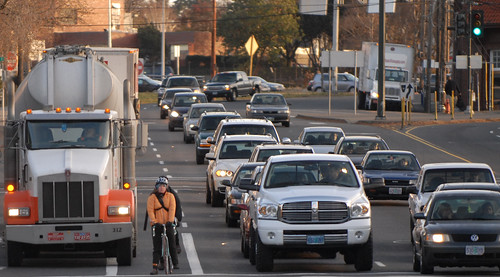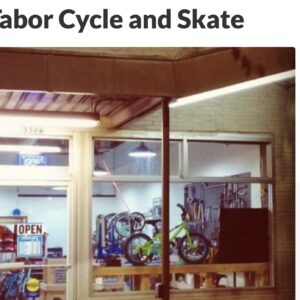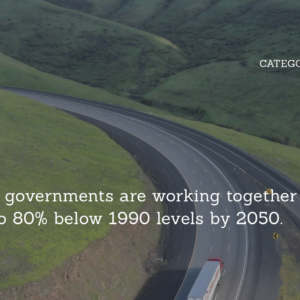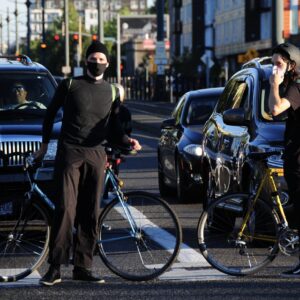
(Photos © J. Maus/BikePortland)
The long, cold war between Portland’s bike/pedestrian advocates and its freight advocates might finally be thawing, people involved in recent talks say.
The latest evidence: Trucking advocates have signed on to soften a set of state rules that might have essentially blocked all new bike lanes, road diets and crosswalk upgrades on state-owned commercial streets such as Lombard Street through St. Johns, Powell Boulevard through Southeast Portland and the Tualatin Valley Highway through downtown Beaverton and Hillsboro.
After two years of discussion, freight and bike/pedestrian experts have settled on a revised state rule that explicitly allows road changes as long as they don’t physically block the passage of wide freight loads.

build relationships with freight advocates
like Corky Collier (R).
Corky Collier, a freight advocate working in Portland since 2004, said communication between bike and truck experts has clearly been improving.
“On a range of 10, maybe it was a 4 in the past, but now it’s more like a 7 or an 8,” Collier said Wednesday. He credited the improvement to solid personal relationships among a few key players.
That’s one reason Bicycle Transportation Alliance Advocacy Director Gerik Kransky has been attending the city’s freight committee meetings, 7:30 a.m. on the first Thursday of each month, since 2010. The fruits of those labors were on display back in December when Kransky worked — with Collier’s support — to restore funding cuts for active transportation when the two served together on the City of Portland’s Budget Advisory Committee.
“Having a few friends goes a long way,” Kransky said.
The state law currently being interpreted is known as the “hole in the air” rule, because it seeks to ensure that wide freight loads — mobile home components, wind turbine blades, large machinery — will always be able to use state highways “unless safety or access considerations require the reduction.”

freight loads under a proposed implementation of state law.
From a biking perspective, there are serious problems with the law, passed with little fanfare by Oregon’s legislature in 2003. For example, it’s far from obvious that wide-load freight should be a top transportation priority on a street that runs right through central Hillsboro — Tualatin Valley Highway, which just this month was named by the BTA as a top prospect for a “world-class bikeway.”
Other roads affected include Route 99 East through central Milwaukie and Route 99 West through central Tigard, as well as U.S. 30 northwest of Portland and all the region’s freeways.
Still, the law is the law, bike advocates involved in the process say — and freight advocates have agreed to significant compromises in its interpretation, including potential reduction of auto travel lanes, restriping to create bike lanes, and narrowly defining the affected streets.
For example, the MLK-Grand couplet through central Portland was one potential corridor that would have been prioritized for wide-load freight traffic. But Metro transportation engineer Anthony Buczek said he’d successfully argued for a clarification that because that couplet is controlled by the City of Portland rather than the state, it would be exempt from the rule. Buczek was also among several who pushed for the addition of a bike lane to not be considered a reduction of freight capacity.
As for the TV Highway, Kransky said he ensured that the proposed rules explicitly state that reducing the number of auto travel lanes — in order to add a buffered bike lane, for example — does not constitute a reduction in freight capacity, either. An off-road path along the highway would also remain feasible, Kransky added.
“They see the opportunity … to have a lot of pedestrian and bike advocates understand the needs of freight movement. Hopefully that’s a two-way street.”
— Anthony Buczek, Metro transportation engineer
“The policy, I think, is a big improvement from where it was,” Buczek said Tuesday. “My sense is that all sides really were committed.”
The Oregon Transportation Commission is accepting comments on the proposed rules until July 15. Among the significant issues is whether low pedestrian bump-outs can be installed without interfering with freight passage. And as talk continues about ways to improve North Lombard Street, it’s not yet clear how these state rules might tie the hands of city planners.
Buczek, the Metro engineer, said freight experts are also eager to persuade active transportation experts that trucking is both important and complicated.
“They see freight marginalized in a lot of ways, whether you agree with that or not,” Buczek said. “So they see the opportunity to have more modes at the table, to have a lot of pedestrian and bike advocates understand the needs of freight movement. Hopefully that’s a two-way street: that we get freight advocates understanding better the needs of pedestrians and bicyclists.”





Building relationships gets things done over the long term. Thanks to Gerik and the BTA for working with freight advocates to create this partnership.
This is going to be a key issue in the Comp Plan as well. We can plan for reductions in single-occupancy vehicle travel, but freight is here to stay.
More bike-ped-freight alliances to reduce SOV traffic would be a very good thing!
I would 100x rather share the road with a professional driver driving a truck than with a personal vehicle. Unlike the personal vehicle, professional drivers are worried about how killing you will affect their livelihoods. I can’t even remember a negative interaction with a CDL-holder.
Or even worse, those monster-truck personal vehicles that seem to be so common out of the central city. The “super duty” pickup crowd is terrifying. The drivers are more likely to act like jerks, and that combines with their vehicle weight to create a truly terrifying experience for cyclists.
Yeah. Those vehicles are the worst. The bane of my existence. Much more terrifying than the tractor-trailers and semi trucks out there.
I’m very grateful for this alliance and glad we’re all talking more, and I am hopeful that it brings good things. Thank you BTA and Freight. Let’s make it safer out there for all of us!
To clarify, the reason MLK-Grand wouldn’t be covered by this statute is it only applies to roads maintained by ODOT. City of Portland maintains the MLK-Grand couplet.
Thanks for the story.
old law:
seems like it allows reduction in order to add bike lanes… bike lanes provide access…
link to new law:
sounds like they can’t reduce the height of the CRC bridge… (;
Put the freight on barges and trains where it belongs. I’m tired of jockeying with double and triple trailers for space on our roads. Our interstate highway system is clogged up with doubles that can’t pull their weight up a hill going 30mph. If the two trailers are too much to haul why are they allowed to haul both at the same time.
The other day Interstate Ave was blocked by a double trailer fuel truck making a delivery. Couldn’t quite make his right turn into the station. Had to sit there and wait 10 minutes for him to maneuver around the corner.
We need to push for increased fuel taxes and registration fees for all vehicles. We need to charge registration and fees by weight, because these are the vehicles that do the most damage and create the biggest hazard. The playing field is not level. Railroads have to pay taxes on their infrastructure, and maintain it themselves. Trucks pay fuel taxes, but they do not even come close to covering the damage they cause (both to infrastructure and to the environment around them).
Just what we need- more hidden taxes that would be passed on to us when we purchase the same goods shipped by those targeted trucks.
Sadly the days of freight rail and barge freight are in the past.
True rail is 3x-4x more energy efficient than trucking (barge freight is close or better bested only by pipeline shipping) but it is MUCH, MUCH SLOWER.
In the mere year and a half that I’ve been driving long haul I’ve seen that rail freight has failed in the USA because its delay: 5-8 days to move a shipping container when trucks can cover the same distance in 1.5-2 days. This is an economic multiplyer: faster freight means more commerce in the same time frame and enables “just in time inventory” (this means NO inventory) so business capital is freed up from inventory owned and real estate to warehouse material for unpredictable freight rail deliveries.
We can track rail’s issues back to its current business model: geographic monopolies. There may no longer be a single nationwide rail monopoly but the break up over a century ago has simply left regional monopolies. The companies each OWN their rail Right Of Way but can change the public whatever the market can bear.
Imagine that ODOT was a private business that owned ALL the state’s roads: you’d play hell getting them to build new capacity unless you specifically paid for it yourself. This is the ultimate source of our dependence upon trucks on public roads versus rail cars on private rail. The public ROW is actively fought for by all and we all get a piece no matter how small it might be; rail monopolies have no incentive to do anything other than laugh in our faces – they effectively OWN the federal government when it comes to this transportation issue. At this level of corruption the only thing that would seem to be capable of fixing our broken rail system is Mussolini.
Boats and barges are just too slow in general and being geographically isolated to coastal access in either the Pacific or Atlantic, unless you add a few extra weeks for the Panama Canal, the freight has to go over land anyways.
I don’t think trucking is smart but the only thing that will displace it is something faster AND cheaper.
This country is actually a leader in train transport, far outperforming Europe. Despite that, there aren’t train stations or docks everywhere freight needs to go. Truck freight is a necessary evil for the foreseeable future. Like living in the city? Thank trucks.
I would hope truckers , contractors, etc, are starting to realize that bicycle, bus, pedestrians, all help reduce traffic jams and are a help to them!
How should we pay for our infrastructure, if not through some form of tax/fee revenue structure? Infrastructure is not, nor will it ever be “free”. Maintenance, construction, planning, design and the people responsible for it all, costs money. And, if considering “privitization” of our streets and highways, we might expect to pay 20-30% more for the same products and services versus State government forces.
…Fuel & Weight-mile taxes are still a better deal than a Sales Tax (or “Hand-me-down” tax – where you might end up paying 40-60% more for the same item after all the middlemen have tacked on their buffer to off-set the sales tax).
The earlier comment about large trucks doing the lion’s share of damage to our roads is accurate – to the tune of 70,000:1 !! With the spiraling costs and limited services for rail transport, in combination of our need to expand our cities further and further into our rural areas, truck transport is about all we have left. (I still have my hopes set on teleportation – thank you, Gene Roddenberry!)
And yes, urban environments are tough on trucks in maneuvering into your favorite fueling station, double parking outside your favorite Starbucks, jockeying in a busy (car-filled) street to deliver the latest fashions to Nordstrom, Macy’s or Kohl’s. BUT, you should try parking a river barge on Macadam, or getting a 450,000 pound diesel locomotive across the St. Johns Bridge!!
Trucks are here to stay. It comes down to a way to get all road users from point A to B as safely and efficiently as practical given our current infrastructure, fiscal, political and technological limitations. With our slow, but steady push toward human power, renewable and more efficient energy sources, we seem to be heading in the right direction. But, with over 100 years of “old school” transportation technology and infrastructure to phase out, upgrade or retrofit, it’s going to take some time…..and a BUNCH of money. 😉